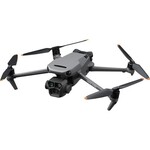This looks like an all-time low price to clear stock before the Mavic 4 Pro launches in early May (apparently stock has already been delivered but there is delay/sales embargo). That is $780 cheaper than the current clearance prices from DJI and other retailers, or $966 with 10% off. RRP is $3,099 so this represents 40-50% off. The price in the DigiDirect Retail webstore is higher, the same as other retailers. The DJI website states that they do not price match eBay (and DigiDirect is not an authorised dealer) and they won't match prices significantly below retail or market price, so I didn't bother to ask them.
That said, DJI does also state:
Despite these exclusions, still submit the enquiry and we'll do our best!
These are brand new AU stock and should be the full retail kit as per below:
1x DJI Mavic 3 Pro
1x DJI RC
1x DJI RC Control Sticks (Pair)
1x DJI Mavic 3 Intelligent Flight Battery
3x DJI Mavic 3 Low-Noise Propellers (Pair)
1x DJI 65W Portable Charger
1x DJI Mavic 3 Pro Storage Cover
1x USB 3.0 Type-C Cable
Available Quantity:
Set at 4 per listing but they have been increasing the quantity and re-listing again once sold out.
This can be confirmed in the edit log of the listing description.
I got a further 10% off with an eBay coupon (not sure which one exactly or whether targeted - it was just listed on the page). That discount applies across multiple items up tot $250 off. Otherwise, you can also get $100 off with eBay Plus.
The difference between this and the standard Mavic 3 (also discounted) is the camera module and the controller (DJI RC*: 1080p 60fps 700 nit display vs. DJI RC-N1 controller which holds your phone as the display).
* * It is the Gen 1 RC controller using O3+ transmission, not the RC-2 with O4. Controllers are not cross-compatible across transmission generation.
In terms of cameras:
- The main camera is a Hasselblad-branded 20MP 4/3" sensor with a 24mm equivalent F2.8 lens with controllable aperture for professional video productions.
- The secondary camera on both is a 12MP 1/2" sensor with a 166mm (7x) equivalent lens; on the Mavic 3 it is F4.4 aperture and on the Pro it has been upgraded with an F3.4 aperture to reduce apparent diffraction softening during the day and improve low-light capture.
- The Pro model adds a third camera on a larger 48MP 1/1.3" Quad-Bayer (capable of down sampling to 12MP in low-light) sensor (similar to what you find in the DJI Air and Mini Pro 4) with an intermediate (2.5x) 70mm F2.8 lens.
- If you want, a wide-angle attachment is available separately for $229 to make the main camera into a 15.5mm equivalent (effective aperture stays at F2.8).





$1759.40 using an ebay plus code APRIL6